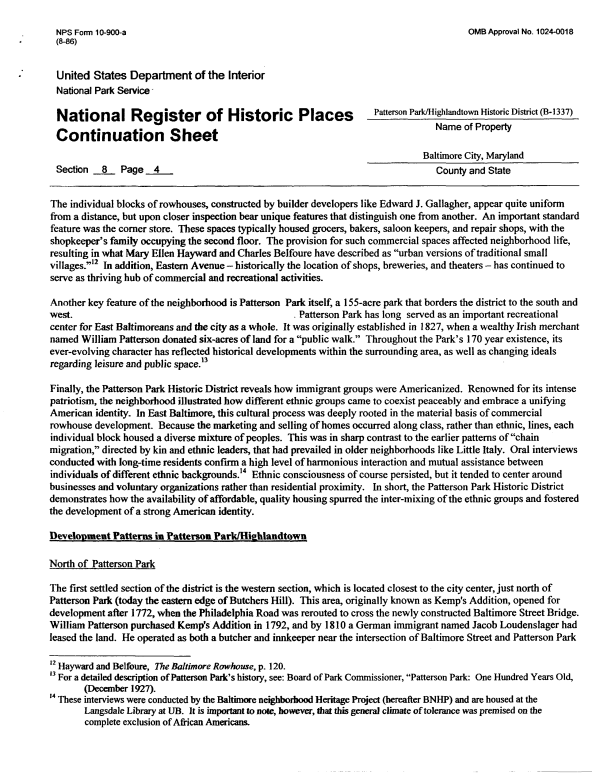 |
||||
|
DEPARTMENT OF HOUSING AND COMMUNITY DEVELOPMENT, MARYLAND HISTORICAL TRUST (Historic Sites Survey) var.d. MSA SE16-3 Image No: se16-3-0099 Enlarge and print image (86K) |
 |
||||
|
DEPARTMENT OF HOUSING AND COMMUNITY DEVELOPMENT, MARYLAND HISTORICAL TRUST (Historic Sites Survey) var.d. MSA SE16-3 Image No: se16-3-0099 Enlarge and print image (86K) |
| NPS Fonn 1 0-900-a OMB Approval No. 1 024-001 8 (8-86) United States Department of the Interior National Park Service Historic District &. National Register of Historic Places f+ -• .- *%•_ A Name of Property Continuation Sheet Baltimore City, Maryland Section 8 Page _4_ County and State The individual blocks of rowhouses, constructed by builder developers like Edward J. Gallagher, appear quite uniform from a distance, but upon closer inspection bear unique features that distinguish one from another. An important standard feature was the corner store. These spaces typically housed grocers, bakers, saloon keepers, and repair shops, with the shopkeeper's family occupying the second floor. The provision for such commercial spaces affected neighborhood life, resulting in what Mary Ellen Hayward and Charles Belfoure have described as "urban versions of traditional small villages."12 In addition, Eastern Avenue - historically the location of shops, breweries, and theaters - has continued to serve as thriving hub of commercial and recreational activities. Another key feature of the neighborhood is Patterson Park itself, a 155-acre park that borders the district to the south and west. . Patterson Park has long served as an important recreational center for East Baltimoreans and the city as a whole. It was originally established in 1827, when a wealthy Irish merchant named William Patterson donated six-acres of land for a "public walk." Throughout the Park's 170 year existence, its ever-evolving character has reflected historical developments within the surrounding area, as well as changing ideals regarding leisure and public space.13 Finally, the Patterson Park Historic District reveals how immigrant groups were Americanized. Renowned for its intense patriotism, the neighborhood illustrated how different ethnic groups came to coexist peaceably and embrace a unifying American identity. In East Baltimore, this cultural process was deeply rooted in the material basis of commercial rowhouse development. Because the marketing and selling of homes occurred along class, rather than ethnic, lines, each individual block housed a diverse mixture of peoples. This was in sharp contrast to the earlier patterns of "chain migration," directed by kin and ethnic leaders, that had prevailed in older neighborhoods like Little Italy. Oral interviews conducted with long-time residents confirm a high level of harmonious interaction and mutual assistance between individuals of different ethnic backgrounds.14 Ethnic consciousness of course persisted, but it tended to center around businesses and voluntary organizations rather than residential proximity. In short, the Patterson Park Historic District demonstrates how the availability of affordable, quality housing spurred the inter-mixing of the ethnic groups and fostered the development of a strong American identity. Development Patterns in Patterson Park/Highlandtown North of Patterson Park The first settled section of the district is the western section, which is located closest to the city center, just north of Patterson Park (today the eastern edge of Butchers Hill). This area, originally known as Kemp's Addition, opened for development after 1772, when the Philadelphia Road was rerouted to cross the newly constructed Baltimore Street Bridge. William Patterson purchased Kemp's Addition in 1792, and by 1810 a German immigrant named Jacob Loudenslager had leased the land. He operated as both a butcher and innkeeper near the intersection of Baltimore Street and Patterson Park 12 Hayward and Belfoure, The Baltimore Rawhovse, p. 120. 13 For a detailed description of Patterson Park's history, see: Board of Park Commissioner, "Patterson Park: One Hundred Years Old, (December 1927). 14 These interviews were conducted by the Baltimore neighborhood Heritage Project (hereafter BNHP) and are housed at the Langsdale Library at UB. It is important to note, however, toat this general climate of tolerance was premised on the complete exclusion of African Americans. |